The MacBook Pro Review (13 & 15-inch): 2011 Brings Sandy Bridge
by Anand Lal Shimpi, Brian Klug & Vivek Gowri on March 10, 2011 4:17 PM EST- Posted in
- Laptops
- Mac
- Apple
- Intel
- MacBook Pro
- Sandy Bridge
Improved WiFi Performance
One of the more notable changes in the 2011 MacBook Pro lineup is a completely different WiFi chipset and subsequent RF design. The previous 2010 MacBook Pro included 802.11a/b/g/n support using a BCM4322 which included full 2x2 MIMO support, meaning two spatial streams were supported. Bluetooth 3.0 was provided by a BCM2070, and the whole solution was simply a BCM954224HMB reference design.

2011 MacBook Pro WiFi+BT Module—Courtesy iFixit
Back when the new Airport Extreme (Simultaneous Dual-Band II) launched, it included one little-hyped feature. One of the most notable improvements over the previous design was inclusion of a full 3x3 radio—again 3 spatial stream support. At the time, there were no Apple products that could actually use 3 spatial streams, and as a result many assumed the feature was completely locked down.
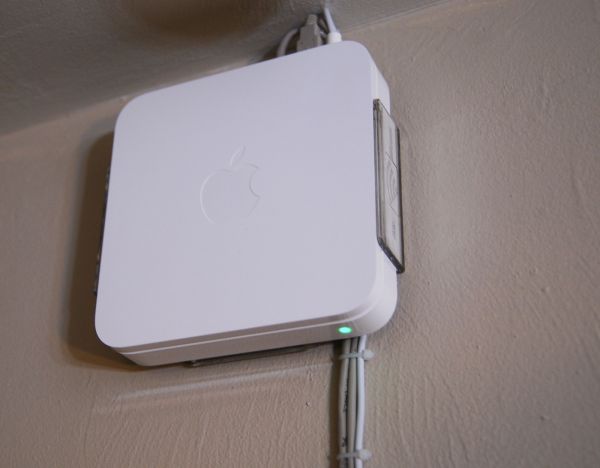
My wall-mounted Airport Extreme (Simultaneous Dual-Band II)
The Airport Extreme has had 3 spatial stream support for a long time to little fanfare. The Airport Extreme still only allows 20 MHz channels on 2.4 GHz spectrum. Other WiFi AP vendors ship firmware which will automaticaly selects 40 MHz channels on 2.4 GHz spectrum per WiFi Alliance rules, but Apple uniformly uses 20 MHz channels on 2.4 GHz. It's a design choice Apple made a while ago which still exists to this day – for two reasons. The first is that it prevents you from being, well, less than courteous and eating up to over 80% of spectrum on the already crowded 2.4 GHz ISM band with one AP. Apple's rationale for disabling 40 MHz channel support on the 2.4 GHz spectrum (for both clients and APs) is that Bluetooth needs lots of bandwidth to hop around on, and already a wide variety of Apple desktop and notebook products come by default with Bluetooth peripherals. Maintaining a good A2DP stereo stream for example requires considerable 2.4 GHz bandwidth. Instead, if you really want 40 MHz channels Apple recommends using 5 GHz, which Apple clients and Apple APs both allow to work with 40 MHz channels.
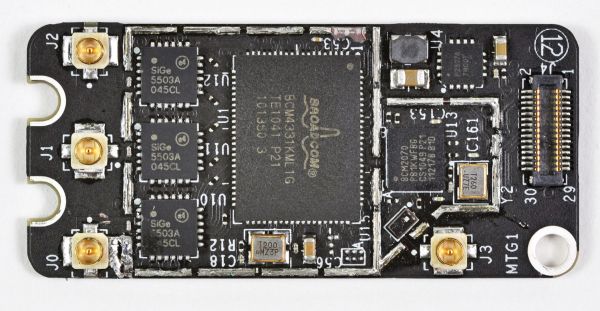
2011 MacBook Pro WiFi+BT Module—Courtesy iFixit
The 2011 MacBook Pro refresh is the first line of Apple products to bring 3x3 radios that can finally enable faster transfer rates and better performance at the edge of WiFi range. 3x3 MIMO support is starting to become relatively common in the PC notebook space, but this is the first for Apple. Inside the 2011 MacBook Pro is a BCM4331 and three clearly U.FL antenna connectors (on the left) for WiFi, as opposed to two in the previous design.
The fourth on the right is for Bluetooth, which remains 3.0 and provided by the same BCM2070 as previous models. Interestingly enough, though the Bluetooth controller is the same, the 2011 MacBook Pro includes newer firmware (37 vs 20), and software (2.4.3f1 vs 2.3.8f7). Hopefully at some point the older design will see a firmware update and bring whatever changes and improvements were made. Though the software versions are different, we couldn't detect any notable differences between the two in practice.

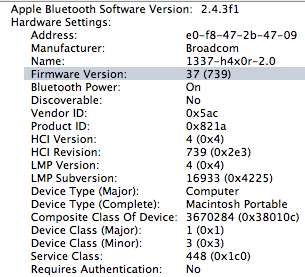
Left: 2010 MBP Bluetooth Hardware, Right: 2011 MBP Bluetooth
However, there's a dramatic improvement in both WiFi range and performance between the 2010 and 2011 refresh. With 400 ns guard intervals 40 MHz channels, 64-QAM modulation, each spatial stream adds n*150 Mbps. With 20 MHz channels, it's 72.2*n Mbps. For example, 1 spatial stream has a data rate of 150 Mbps, 2 has 300 Mbps, 3 has 450 Mbps, and so forth all the way up to 4 spatial streams and 600 Mbps as defined in the 802.11n specification. The reality of the matter is that what physical layer rate you'll see depends on the modulation and coding scheme and how many streams are going. You can look those up at any time by holding option and clicking the WiFi indicator, and looking them up in a table.
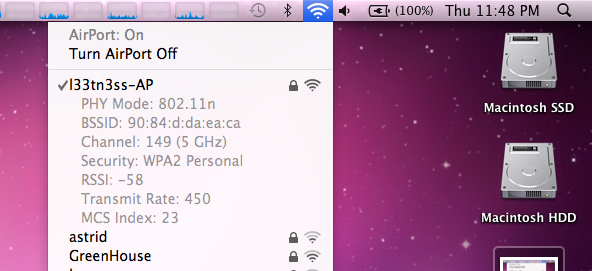
We tested a 15" 2011 MacBook Pro alongside a 15" 2010 MacBook pro connected to an Airport Extreme (Simultaneous Dual-Band II) running latest firmware. I originally suspected that 3 spatial stream support wasn't enabled, and that Apple would push a firmware update out right after their first 3 spatial stream products started shipping. Interestingly enough, it's always been there, enabled, this is just the first client I've gotten my hands on that does it. I'm not a huge fan of the Airport Extreme (I use a WRT54G-TM with Tomato and a WRT-600N with DD-WRT), but it's the only thing on hand with 3x3 MIMO. I tested in four different locations in my house—in my office, living room, kitchen, and outdoor patio. The base station is in my office mounted on the wall close to the ceiling, and those locations are subjectively ordered from best to worst.
To test, I initiated a large transfer over SMB (from a Windows Server 2008 R2 install with a 5 TB RAID5 array connected over gigabit ethernet) on each client, continually pinged AT, and at each location checked the reported transmit rate and RSSI. What we're reporting here is again the physical layer link. I'll show in a second that real-world transfers also improved, this just gives some perspective for what raw link rates are being negotiated at each location.
| WiFi Transfer Rate Differences—802.11n | ||||||||
| 2011 MacBook Pro | 2010 MacBook Pro | |||||||
| RSSI | Transfer Rate (Mbps) | RSSI | Transfer Rate (Mbps) | |||||
| Location 1—Office | -44 | 450 | -42 | 300 | ||||
| Location 2—Living Room | -61 | 130 | -64 | 117 | ||||
| Location 3—Kitchen | -69 | 117 | -68 | 78 | ||||
| Location 4—Outdoor Patio | -85 | 20 | -84 | 13 | ||||
In most cases, RSSI is within the margin of error. RSSI is generally not something you can compare, but since both wireless chipsets are Broadcom and the numbers are so close, it seems they're reported the same way and probably just dBm. Just know that generally it doesn't work that way unless you're lucky. What's important, however is that the negotiated link speed is noticeably better in essentially all locations on the new 2011 MBP. Even when the extra antenna isn't being used for a spatial stream of its own, it's actively improving link quality and helping the new MBP negotiate higher physical layer speeds.
So how much of a difference does 450 Mbps 3x3 make over 300 Mbps 2x2? With both in the exact same spot in my office, I saw throughput of 98.1 Mbps on the 2010 MBP compared to 113 Mbps on the 2011 MBP. The modest 15% improvement over the previous generation's wireless chipset isn't dramatic, instead the dramatically improved range is.
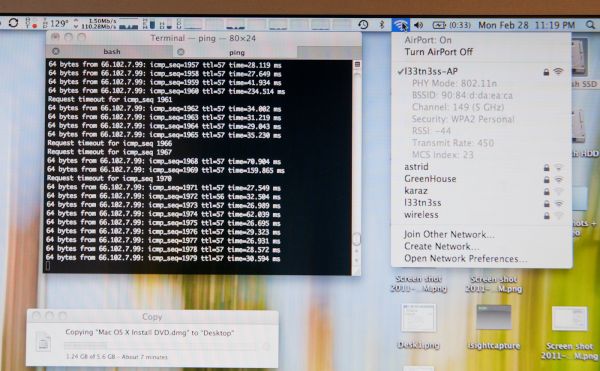 110.28 Megabits/s over WiFi. I later saw sustained 113 Megabits/s.
110.28 Megabits/s over WiFi. I later saw sustained 113 Megabits/s.
Subjectively, I found many more APs visible with the new MBP. I was able to cling onto my AP all the way out to the curb (just like smartphones) when connected on 2.4 GHz, something the old generation just couldn't do.
The only complaint I have about the new wireless chipset is that it seems to hunt around for what rate it wants negotiated. I saw a number of different MCS (modulation coding scheme) values with the 2011 MBP in the exact same place. Link rates from just below 300 Mbps all the way up to the expected 450. It seems to settle out at the expected 450 Mbps in the same room as the AP, it just takes a while, whereas other 2x2 stacks I've seen always lock onto 300 Mbps and stay there in the same room and position.










198 Comments
View All Comments
Wolfpup - Friday, March 11, 2011 - link
Just LOOK at that. Visually it just makes things look worse...looks like it's taking up space for maybe two more cores, or a fifth core and more cache, or something.The only good thing about it is it may help AMD get back in the game. Assuming Bulldozer ends up relatively competitive, AMD's going to be able to have more cores or cache in the same die space, or else have a smaller CPU with the same performance.
Personally I'm a big fan of Intel's rock solid stability, but it feels like AMD gets better and better with that, where they feel like a real competitor now, and I'd love to see them get parity with Intel or even surpass them!
To people who have called the higher end config's GPU "high end", it's not. It's a decent mid range part. For the price it ought to have better...maybe that on the low end config and an 800 core part on the high end config (or a Geforce GTX 460), but at least it's a big jump up from the last gen models.
Belard - Saturday, March 12, 2011 - link
UH... and what reliability issues are you talking about with AMD? What, intel never screws up? I buy, own and sell both brands.Wardrop - Friday, March 11, 2011 - link
To be honest, I'm somewhat surprised that Apple don't offer a solution for reducing cable clutter, given their minilast design of the iMac, etc. A docking station sounds like an obvious solution. I'm sure Apple could come up with a really elegant way of docking your Macbook, or otherwise, just connecting all your cables via one main connection.I envisage a magnetic solution. You could either have a docking station, where the Macbook sits on something (a stand would be nice). Otherwise, a breakout box type of device, where you plug all your audio, USB and display cables into it, and then attach the breakout box to a single interface on your Macbook, whether it be a plug on the back, the side, or even a magnetised strip on the bottom of the notebook?
I use my Macbook Pro primary as a desktop. It goes through my desktop KVM, to which my Windows desktop is also connected. I try to avoid unplugging my Macbook from my desk however, simply because it's a hassle. I not only have to unplug the cables, but I have to eject my external time machine drive. One of the most annoying things I find however, is that because the screen resolution on my MBP is significantly lower than my desktop monitor, it often screws up all the windows. I find I need to spend time resizing all my windows for the 13" MBP display, and then have to do the same when I connect it back up to my 24" desktop monitor. When you've got 10+ windows all perfectly arranged to suit your working style, it's a major pain, hence I avoid taking my MBP off the desk.
tzhu07 - Sunday, March 13, 2011 - link
I was thoroughly unhappy with the current offerings for a docking station for my late 2006 macbook pro, and so I decided to go to home depot and build one myself. And I made it super elegant and wirefree. Also helps that my monitor is connected to an arm, keyboard wireless, and also mouse is wireless too.http://www.majorindulgence.com/file_exchange_data/...
ahhhhhhhhhhh.....super clean
bronze5420 - Friday, March 11, 2011 - link
this is definitely the best computer review i have ever read. very informative. answered all the questions i had and then some. keep up to good work. and does anybody know if OSX Lion will feature TRIM support for third party SSD's?13579abc - Friday, March 11, 2011 - link
First let me echo the sentiment of gratitude expressed throughout this forum. AnandTech really is a cut above other tech sites.Second, if I may add my two cents, heat and noise are such an important part of the mobile experience that they might deserve a little additional attention in this review, particularly given that apple tries to differentiate itself from competitors in these areas. This review touches on the surface temperatures of these new Macbook Pro models, but I wonder if there are any plans to more thoroughly examine surface temperatures in different areas of the notebook (i.e. palm rests, keyboard, bottom surface…). Also, does AnandTech have any comment on the effect of inappropriate quantities of thermal paste reportedly used in the notebooks? Some forum posts report amazing thermal improvements resulting from properly applying new thermal paste, but to be honest I have some doubts regarding the validity of these posts and think that they might be misleading.
Along similar lines are there any plans for a quantitative analysis of the noise output from these new models.
Again,thanks for a great review.
tipoo - Saturday, March 12, 2011 - link
Seconded, some numbers on thermals and decibels would be nice.Balfa - Saturday, March 12, 2011 - link
I've just bought the new 17" that I use mainly for software development but even at 1920x1200 it is a little on the cramped side. So at home I connect it to a Cinema Display 27'' via mini DP cable to the new combo TB-MiniDP port. And the monitor cable use also a Magsafe connector and lastly a usb2 for camera, sound and 3 usb ports at the back of the monitor like most folks already know likely.Now what I really wish for the future Apple is extends that paradigm of a monitor-docking station with a new 27'' monitor with only the Magsafe and one Thunderbolt cable. At the back of the monitor implements every ports that could be needed: USB3, FW800 (1600 maybe why not), eSATA (unlikely I know). And lastly add a powerful discrete GPU in the monitor itself with a quick access door to upgrade it if needed. That way you could remove the one in the MBP for lower cost and better battery life and still have a powerful GPU solution at home for gaming, transcoding and the like.
I think the monitor is the best place for docking a laptop, not needs for a separate device. I already put all my external disks behind it anyways (I place my monitor in the middle of the desk so there's a lot of empty space behind) and it will be the shortest route to plug them, less clutter that way. Gee it's a great idea isn't it!
MrBrownSound - Saturday, March 12, 2011 - link
Once again anandtech pulls off a amazing review. With this information I can cofortably say I will wait for Lion to come out.ProDigit - Saturday, March 12, 2011 - link
None of these machines is worth their price!The 13" has a price of a 16" laptop